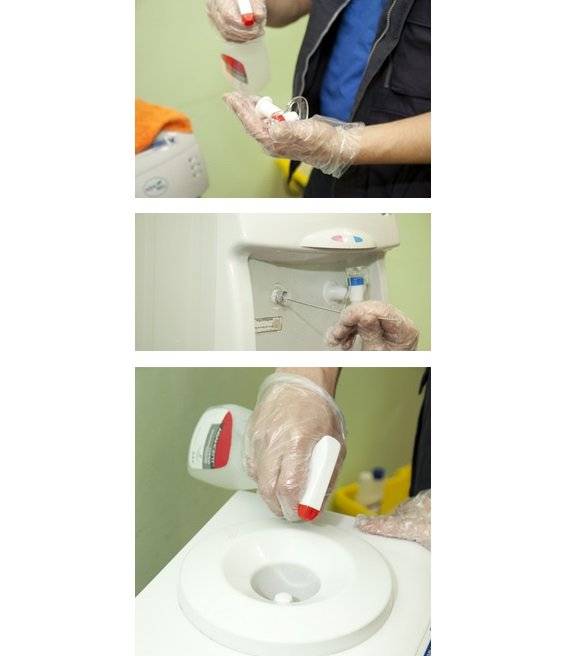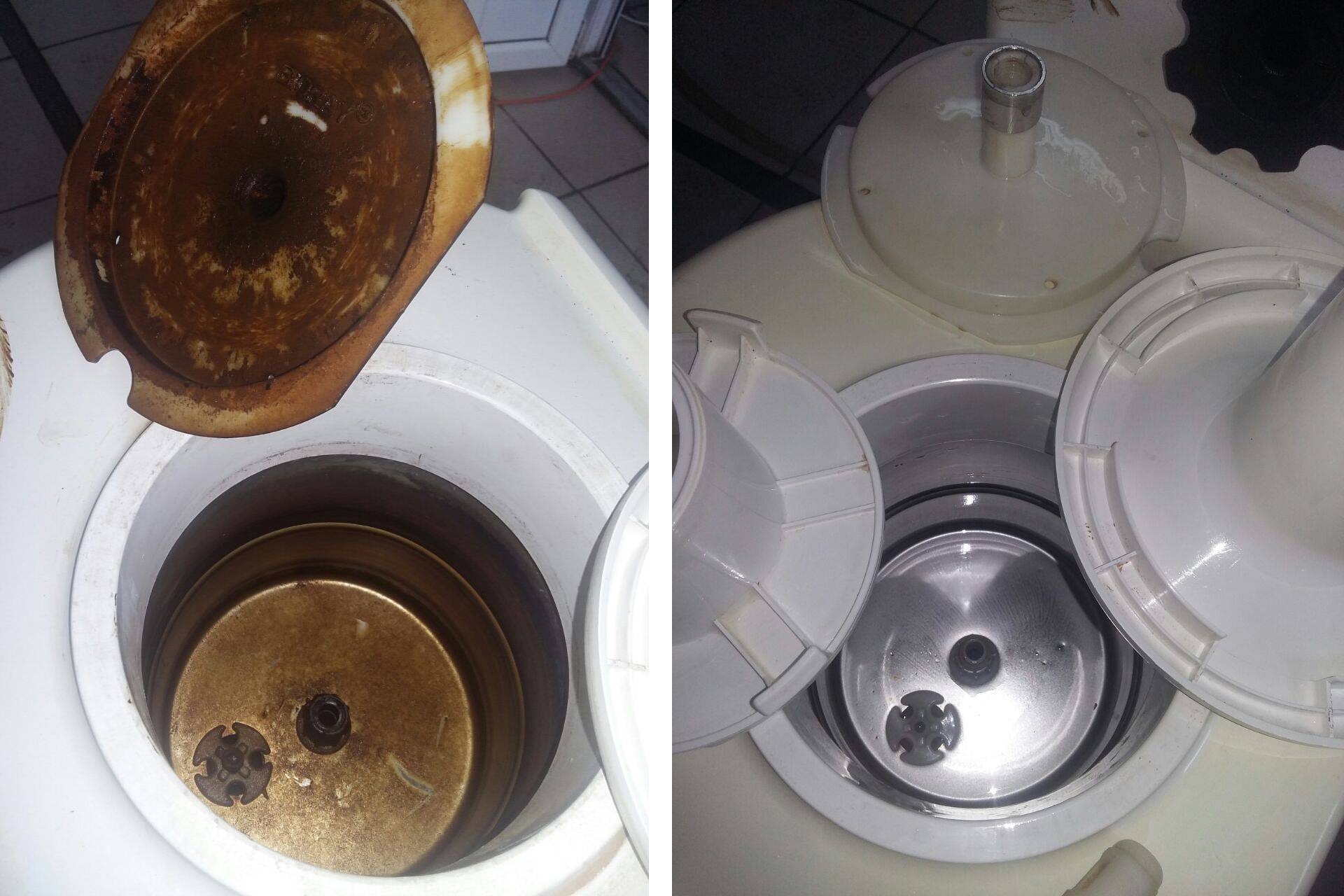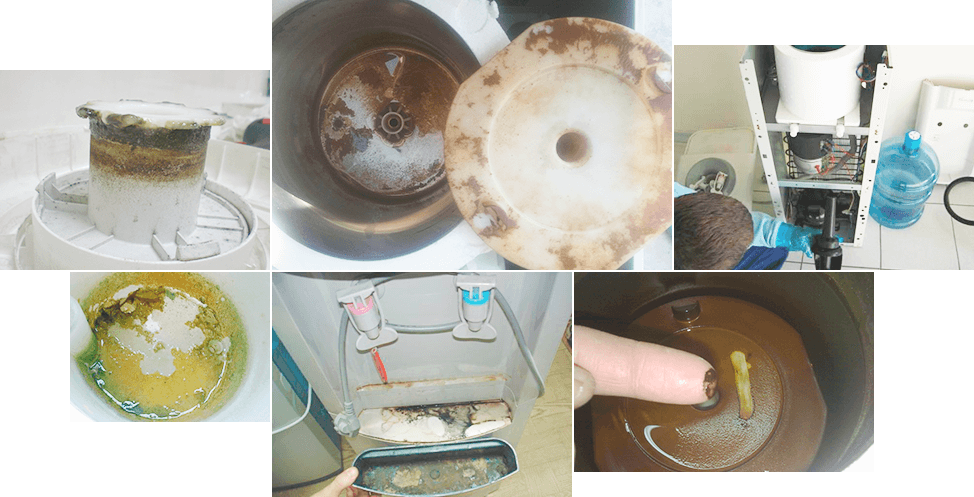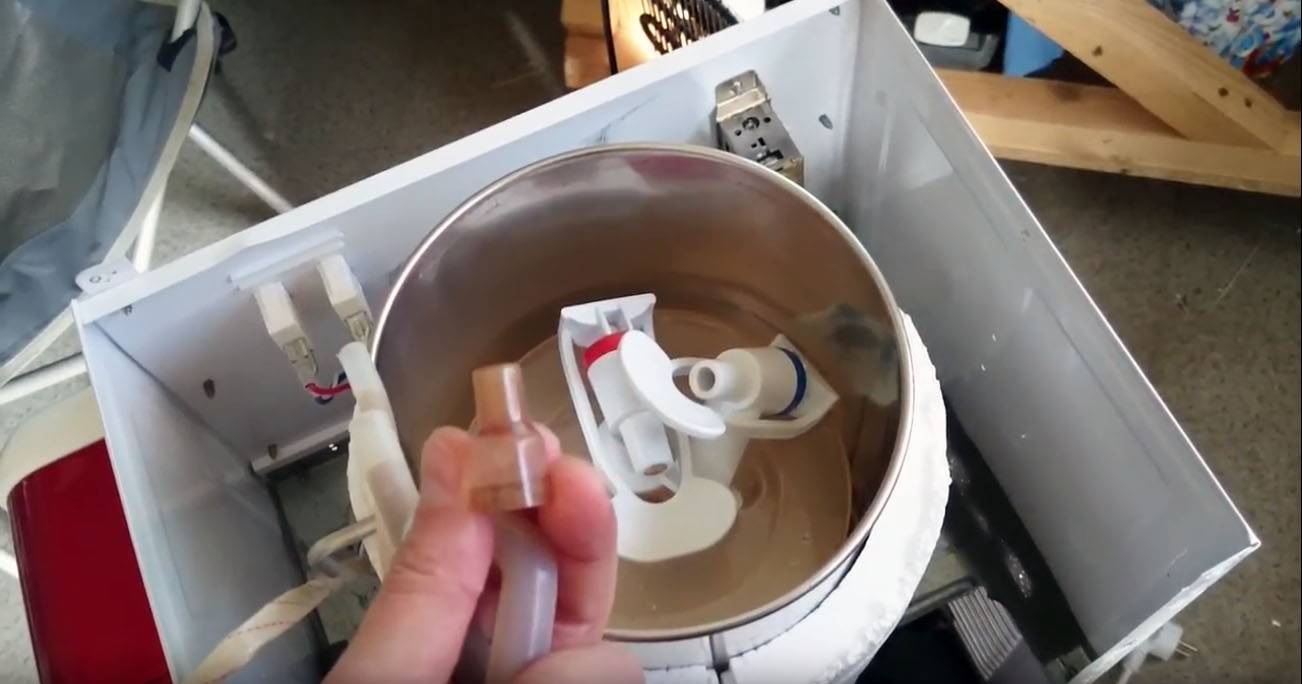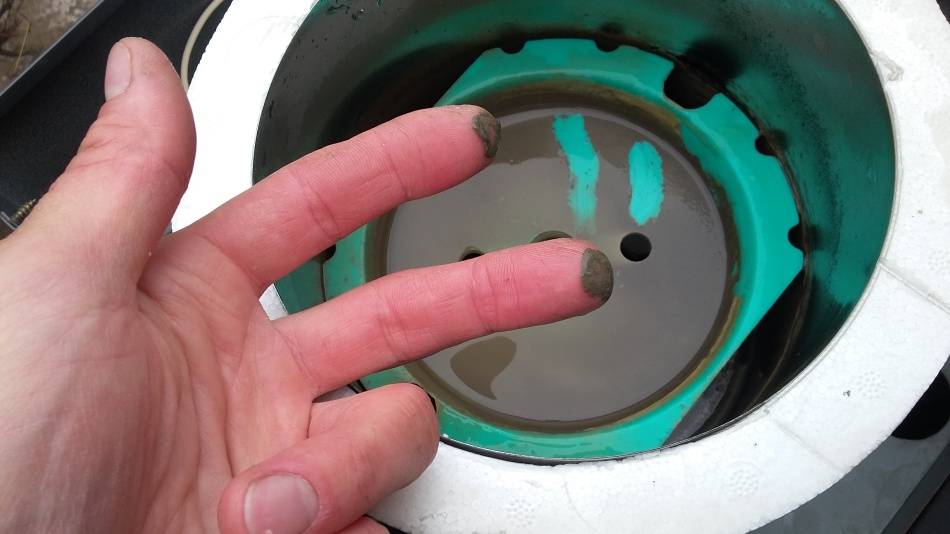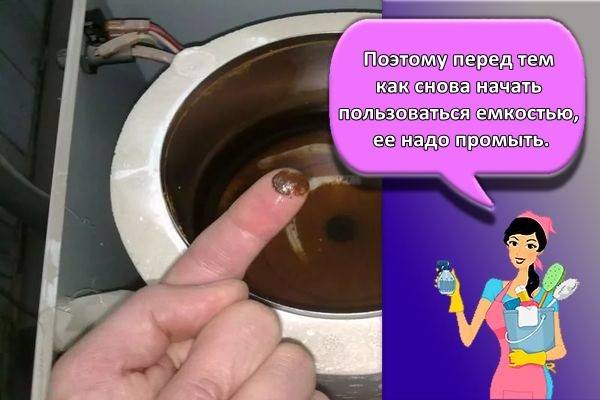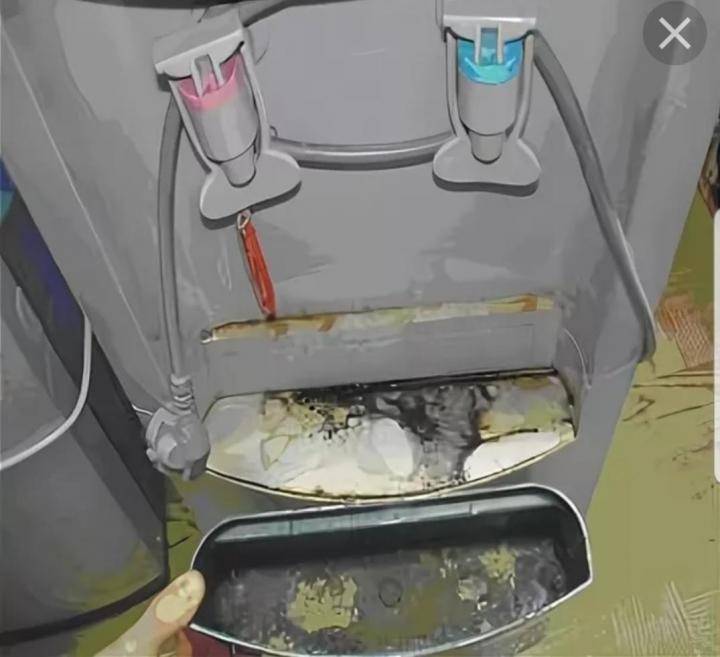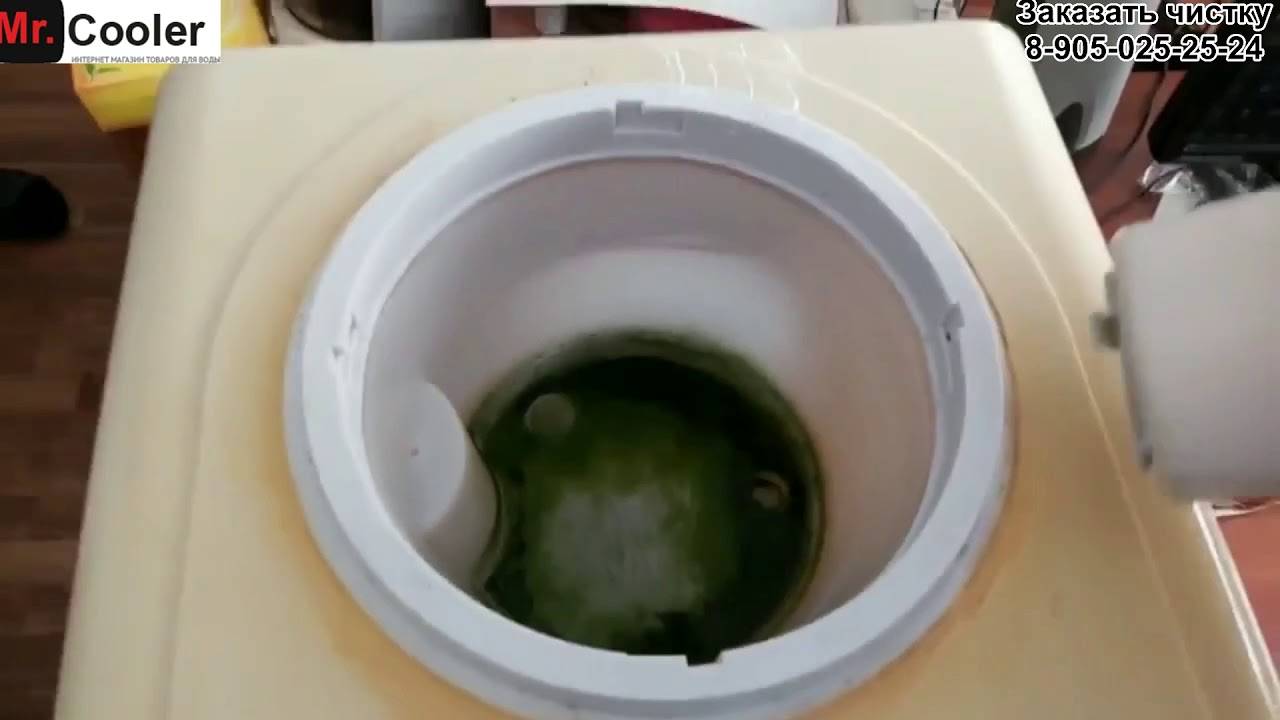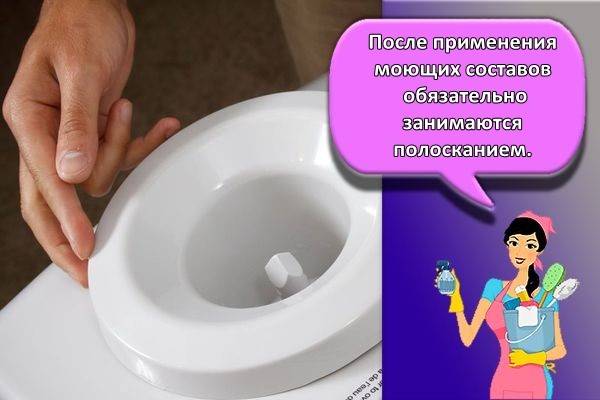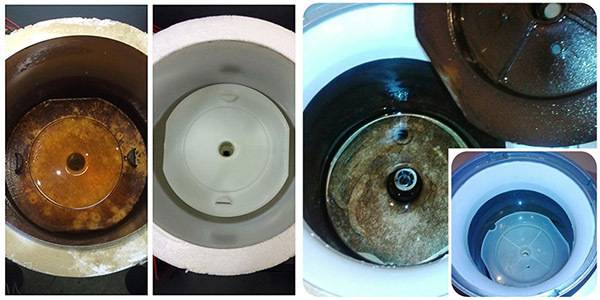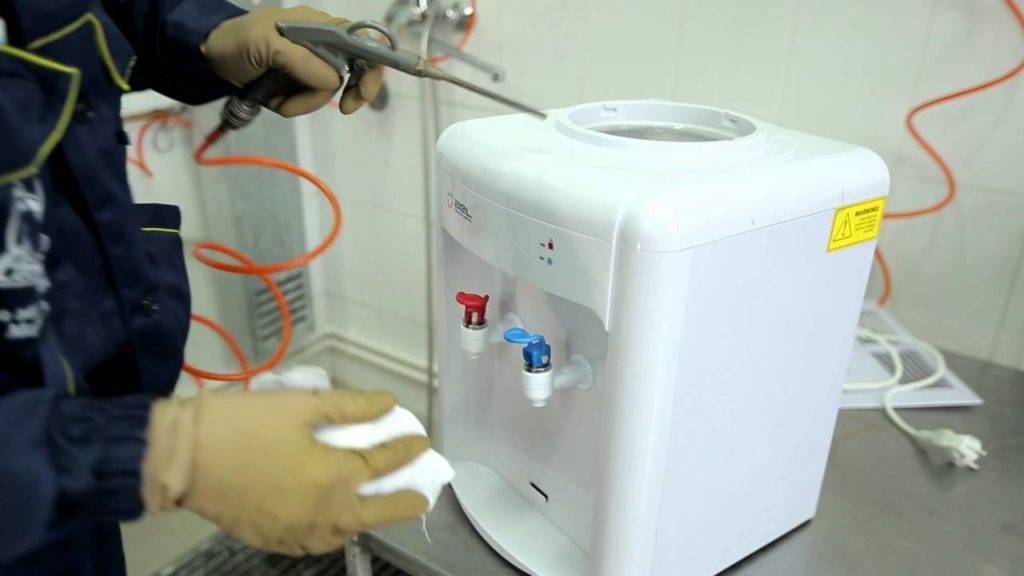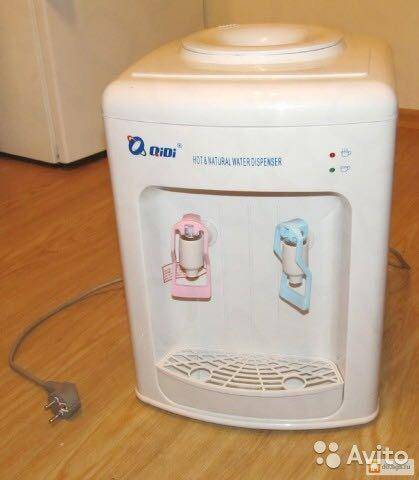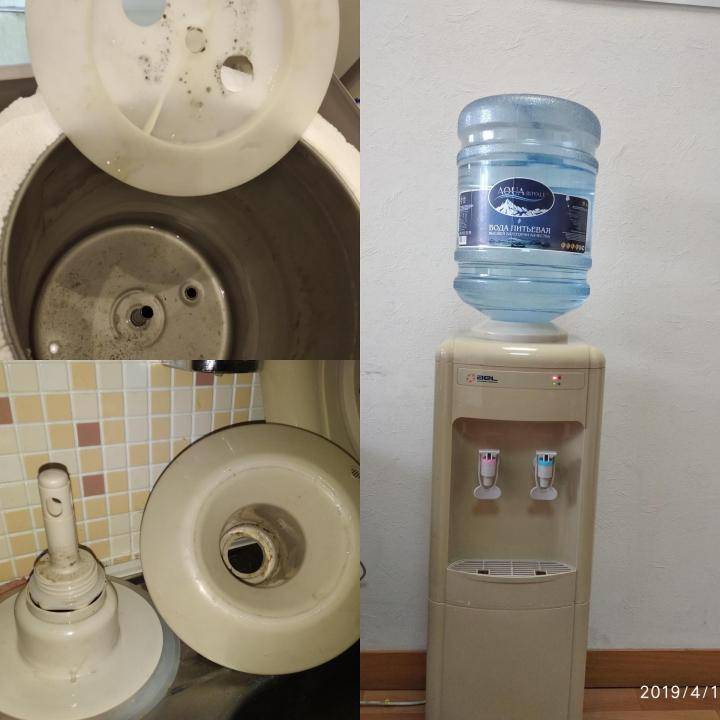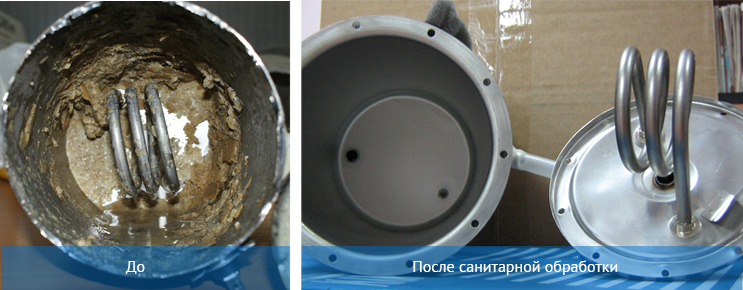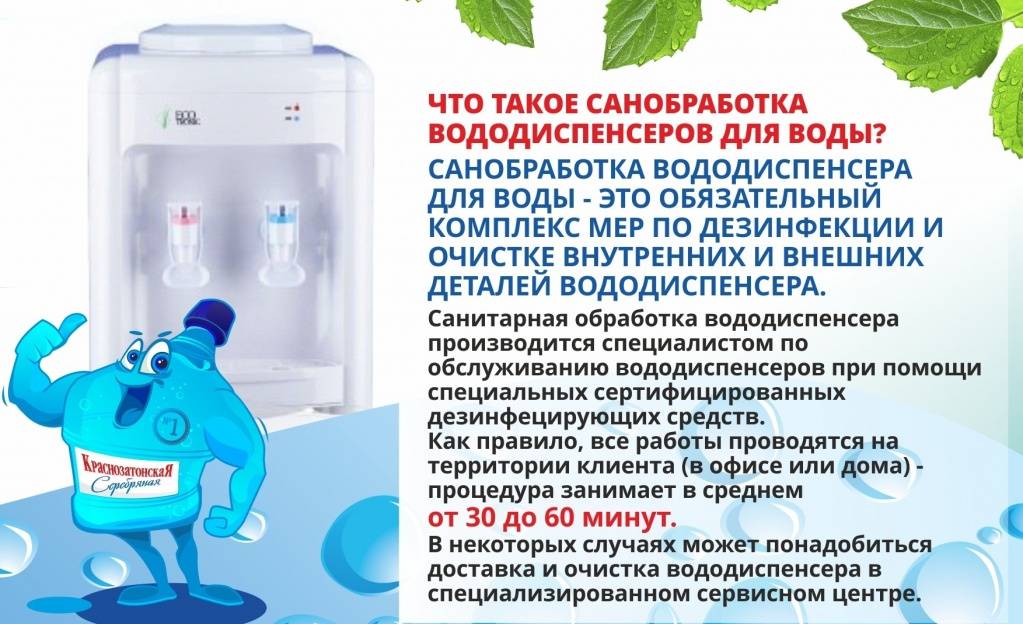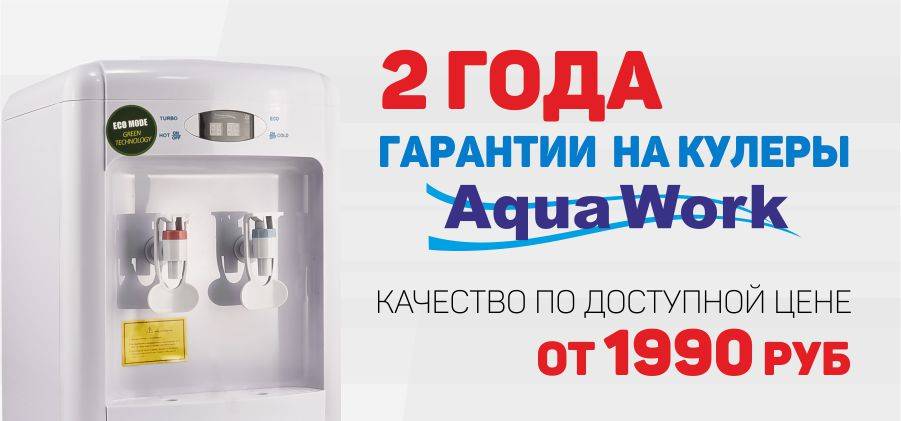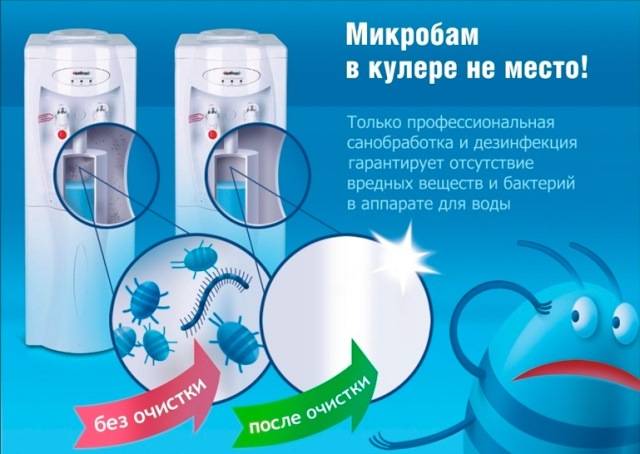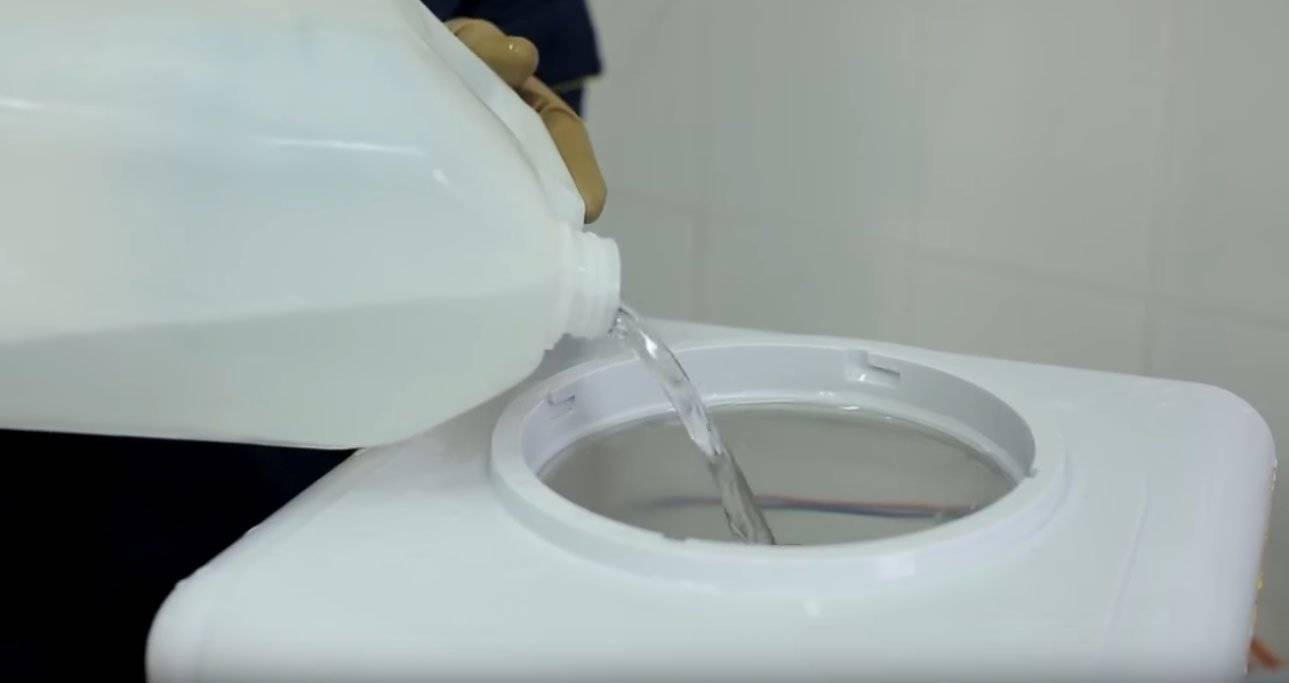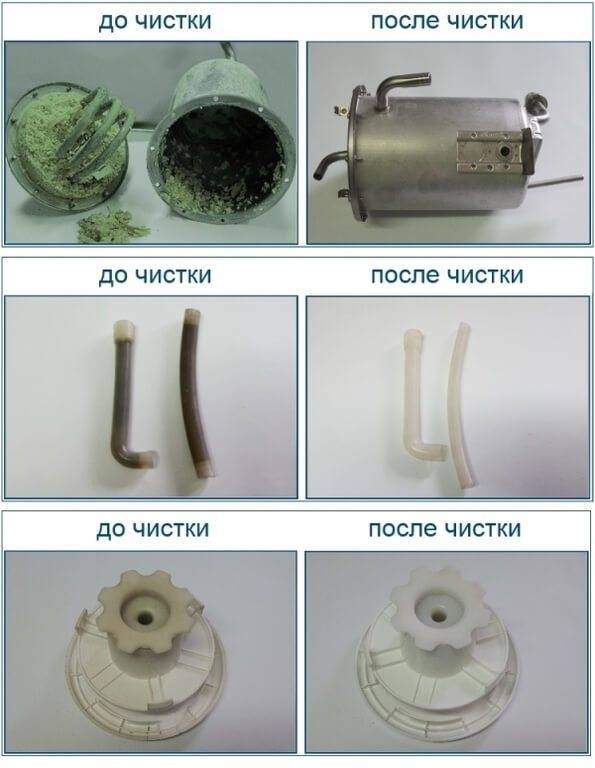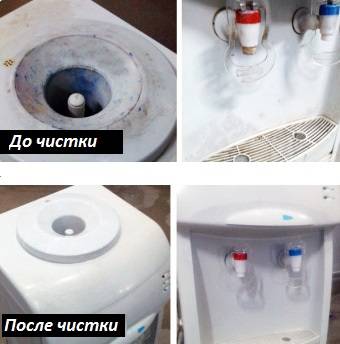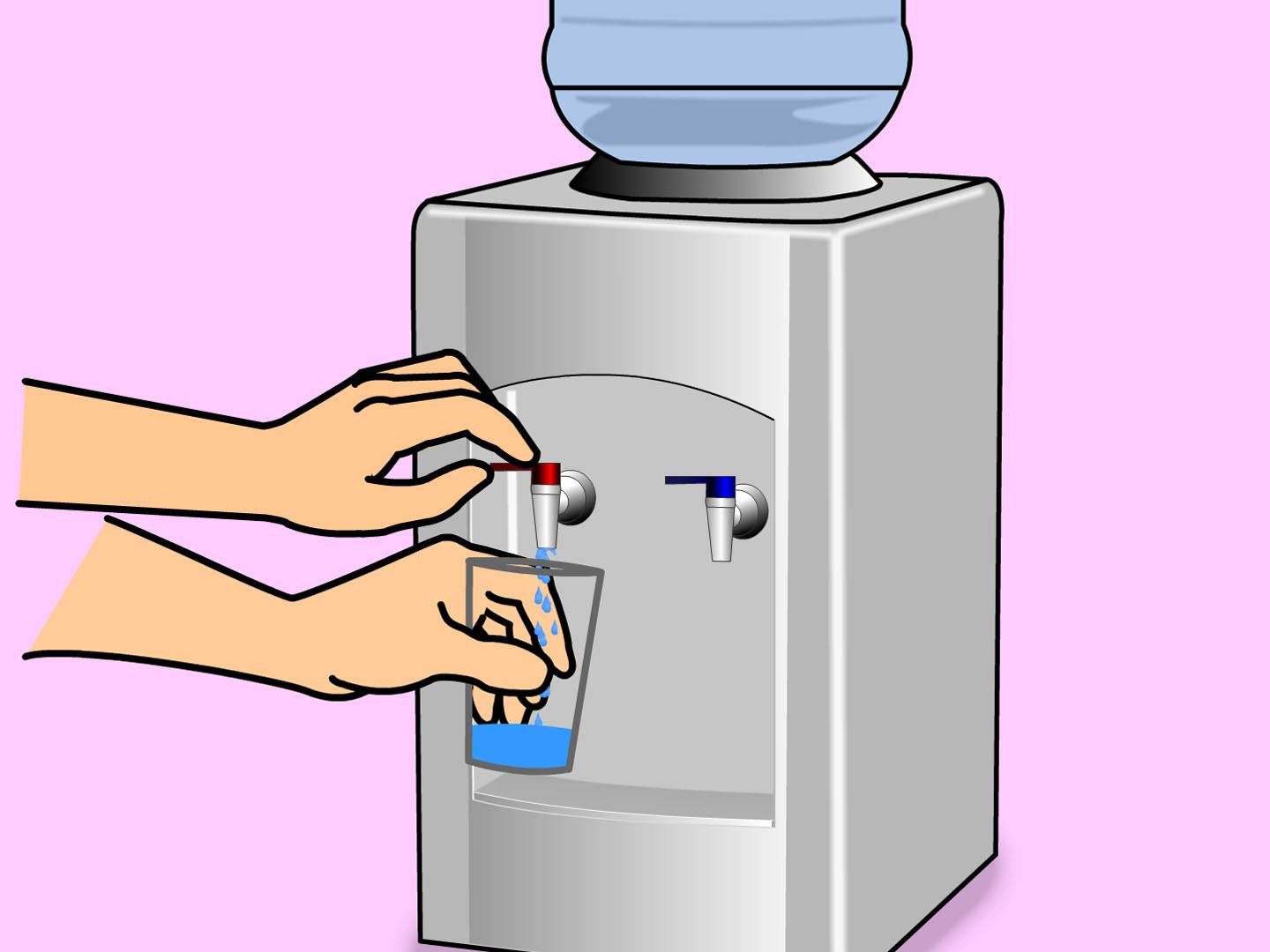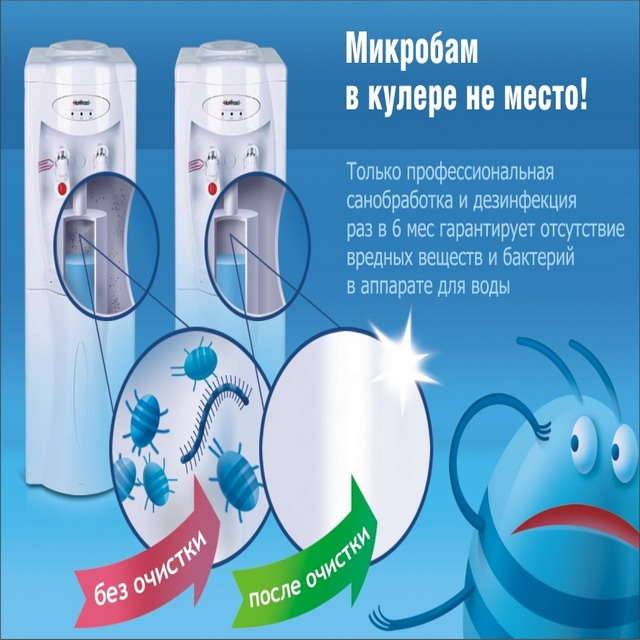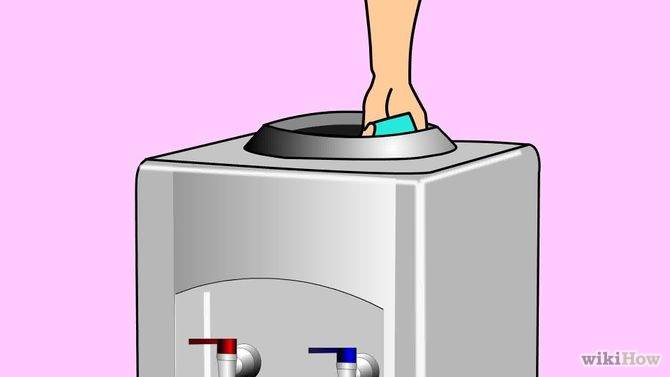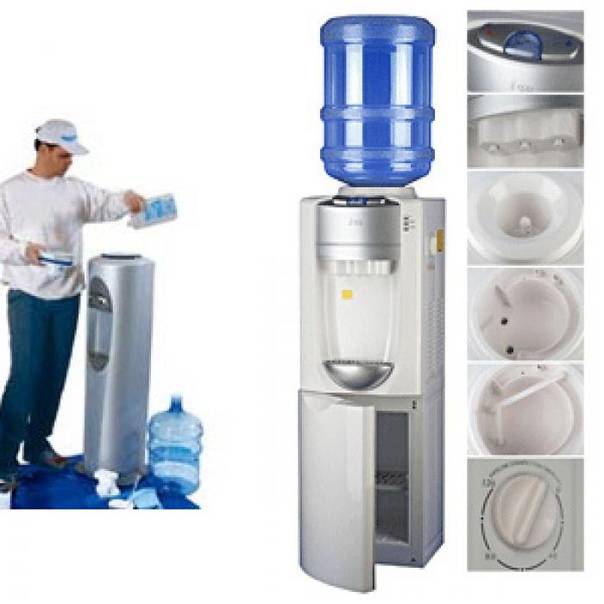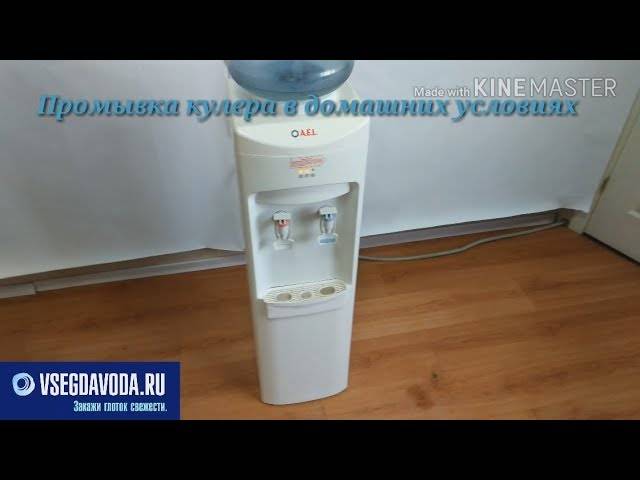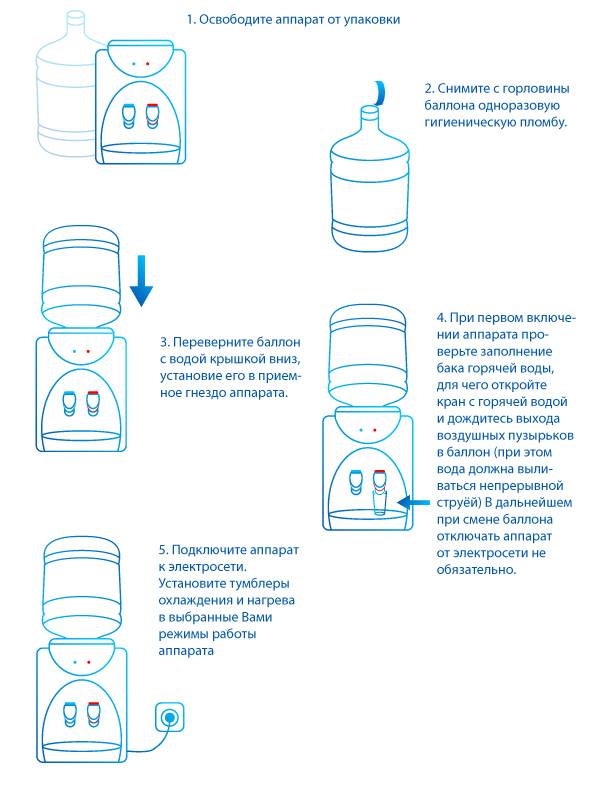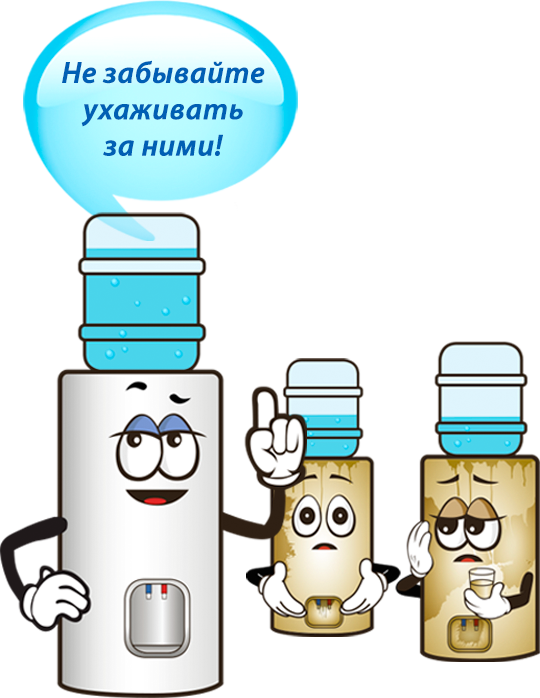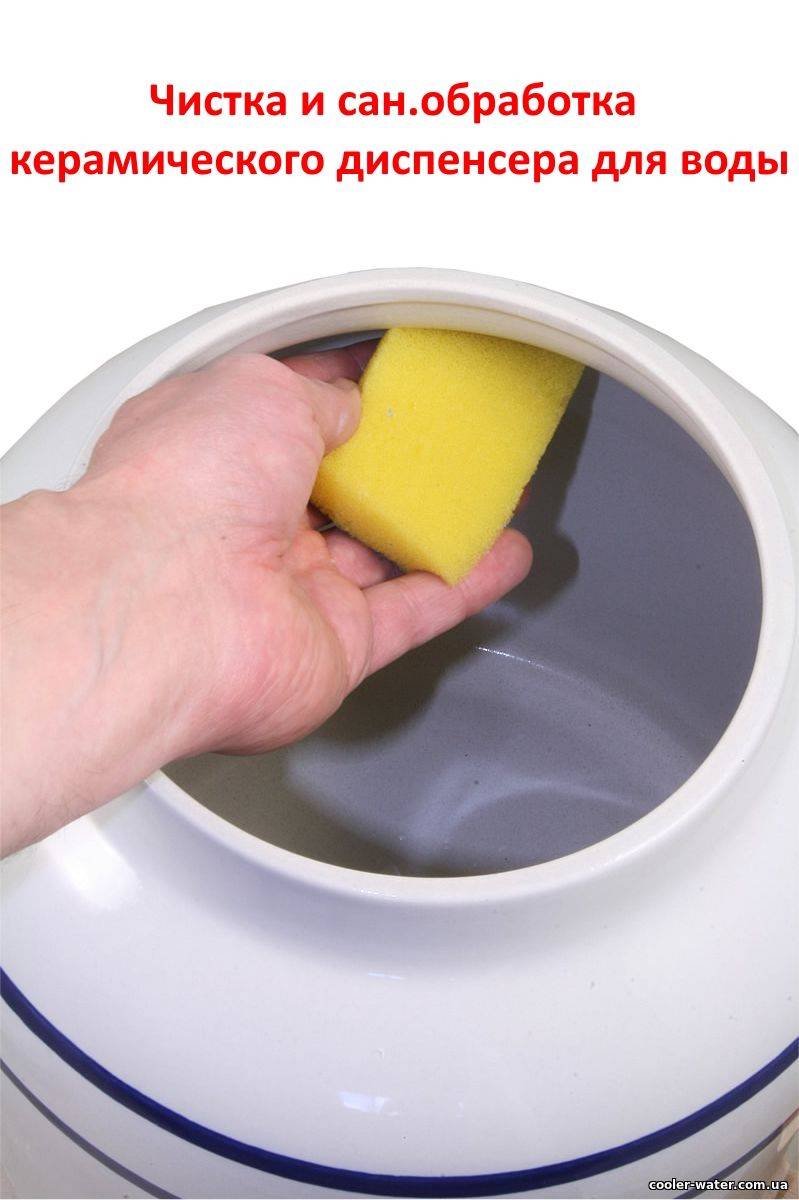Correct cooler cleaning sequence
Cleaning the water cooler is more expedient when the water in the bottle is almost or completely empty, this will facilitate and speed up the process.
Important!
First of all, be sure to disconnect the device from the mains!
Further, we adhere to the following order of actions.
We wipe the body of the device with a damp cloth, it can be antibacterial or soaked in a special solution.
We drain the remaining water from the container and remove it from the apparatus.
To flush the device, we sequentially drain the water first from the hot water tap, and then from the cold tap.
When doing this, be careful not to burn yourself with the hot water.
Pour out the remaining water by unscrewing the plug from the drain hole, which is located on the bottom of the device. On some models it is located on the rear wall.
Then we screw the cork back.
We unscrew the bottle receiver by turning it counterclockwise.
Pour a citric acid solution into the open hole, which is prepared at the rate of 100 g per 5 liters of water.
Both tanks should be filled to the top. To verify this, open the taps - water should pour out of them in a continuous stream.
Plug in the appliance and press the switch. As soon as the water heats up, unplug the device.
Then you need to wait 5-6 hours for the device to be disinfected inside. During this time, you can clean other parts of the device. Remove all disassembled parts from it: drip tray and grill. Then rinse them with dishwashing detergent along with the bottle receptacle.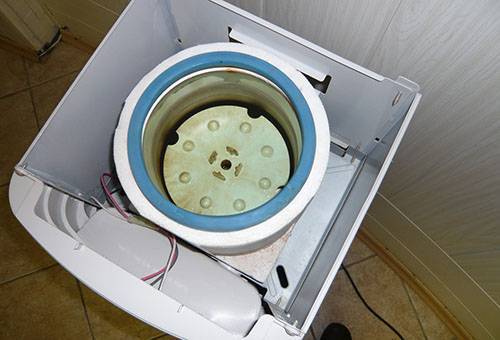
After the specified period, we drain the water from the device, as before, first from the taps, and then through the drain hole. Here it is required to unscrew the taps and clean them with a brush using the Antiklin spray. If it is not there, a dish detergent is suitable at home. Then rinse the taps thoroughly and screw them back. Then fill the entire system with clean water and drain using the familiar pattern. The procedure can be repeated 2-3 times to completely rinse out the cleaning solution and loose limescale. Then you collect the entire apparatus, install a new bottle and enjoy clean and fresh water with a sense of accomplishment.
Tips for cleaning your home cooler
The following tips will help to simplify the process of cleaning the device and save you from many unwanted mistakes:
- It is not recommended to choose abrasive products for cleaning. These include kerosene, acetone and gasoline. They are unsuitable and not designed for this type of work.
- Do not pour cold water into heated cisterns. You should wait until they cool down.
- When changing bottles, do not forget to disinfect the area of contact between the bottle and the bottle receptacle. This is done with antibacterial agents.
- Cooler is advisable to keep the shade. Sun exposure degrades the quality of the water (it can ferment). The walls of the cooler are also damaged. Covered with green foil.
- Cleaning with detergents is best done away from children and wearing rubber gloves. And your hands will be safe, and you will protect the cooler from the ingress of new microbes.
- The bottle receptacle is washed frequently. At least 2 times a week.
Cleaning the cooler is an important and necessary step on the way to improving the quality of the device. By regularly disinfecting the device, you extend its life and allow yourself to drink clean water, which has a beneficial effect on health.
Causes of water pollution
Water itself can be a source of pollution in the first place. Actually, that's why it is recommended to buy it only from trusted suppliers.The second most common cause is dirt and bacteria on the hands. If the neck of the bottle can still be protected with a protective film, then the ingress of microorganisms inside during its installation is inevitable. All this leads to their intensive reproduction, up to the appearance of colonies already inside the device - a characteristic plaque is formed on the surface and, as a result, the cooler is cleaned.
 Any cooler requires timely care, washing and cleaning.
Any cooler requires timely care, washing and cleaning.
In addition, the deterioration of water quality can be caused by the following factors:
- Lack of personal hygiene. No one can guarantee that all household members or employees in the office scrupulously adhere to elementary sanitary rules!
- Unfavorable external environment. Dust in the room, lint from floor coverings, small particles contained on outer clothing - all this sooner or later ends up inside the dispenser.
- Small insects and rodents. It sounds shocking, but it is a fact. Many public institutions where such devices are installed are at risk of spreading infections precisely because of the local "fauna".
- Scale build-up. Can indirectly cause damage to the cooling fan.
 Mineral salts present in the water contribute to the formation of plaque and scale.
Mineral salts present in the water contribute to the formation of plaque and scale.
Why do you need cleaning
The lack of timely cleaning of the cooler can not only lead to breakdown of the device itself, but also harm human health. Over time, biofilm inevitably appears on the inner surface of any container, which contaminates the water with dangerous microorganisms, which causes an unpleasant smell and taste. Limescale also forms in the heating vessel, resulting in a yellowish precipitate.
If the device is not cleaned in a timely manner, its efficiency decreases:
- tap water flows worse or stops flowing altogether;
- the cooler “boils” without ceasing;
- the device may be completely damaged.
If the owner has noticed at least one of the above signs, it is recommended to immediately clean the cooler.
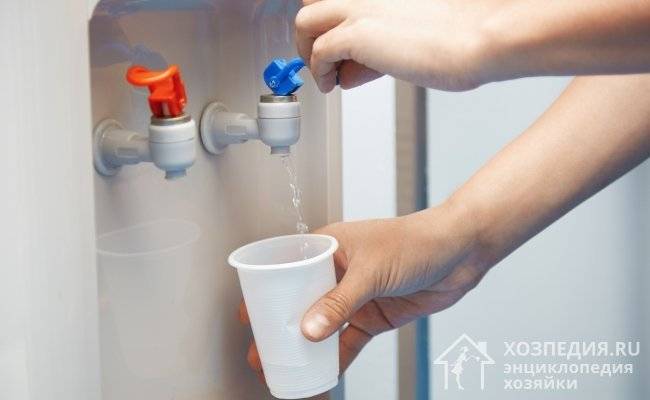 Weak water flow from the tap indicates that the device needs cleaning.
Weak water flow from the tap indicates that the device needs cleaning.
Instructions for self-cleaning the water cooler:
The ideal time to clean your cooler is to replace an empty bottle with a new one.
Wash your hands with soap and water.
Disconnect the cooler from the mains.
Remove and rinse the drip tray thoroughly under running water using a small amount of dish soap.
Wipe the cooler case with a damp soft cloth.
Remove the empty bottle from the drip tray.
Drain the cold water and hot water from the tap into a previously prepared container. Be careful to make sure the hot water has cooled down first.
Open the plug of the water drain valve located on the bottom or rear panel depending on the model of your device, remove the remaining water from the system and close it again.
Unscrew and rinse the taps with a brush and dish detergent. Rinse them thoroughly in running water. Put the taps in place: on the right - cold blue, on the left - hot red.
Prepare a solution for cleaning the cooler: dissolve 100 g of citric acid in 5 liters of water. Use only clean utensils to prepare the solution and stir the citric acid powder well.
Turn the bottle receptacle counterclockwise and remove it from the device.
Slowly pour the prepared citric acid solution into the cooler through the hole where the bottle was located.
Check the fullness of the tanks, for this, substitute the container and press the hot and cold water tap. A continuous stream indicates fullness. Add solution if necessary. The volume of the tanks is different for different models of coolers, so you may have a solution left.
Connect the cooler to the mains and set the hot water switch to ON.
Wait until the water in the system heats up, the heating indicator should turn off and disconnect the device from the mains.
Leave for 5-6 hours to disinfect.
Drain the solution from the system through cold and hot water taps, the rest through the valve.
Rinse the cooler with clean water, it is better to use bottled water instead of tap water. To do this, pour about 4 liters of water into the system and drain as described above. It is better to repeat rinsing with clean water.
Attention! Do not use water that was used to flush the system. It may contain traces of disinfectant.
Screw the bottle receptacle back on and remember to close the water drain valve.
Place a full bottle on the cooler.
Connect to the mains.
Wait for the water to heat up and cool down
The cooler is ready to use.
How to descale a cooler
Sanitary treatment of coolers from scale is necessary for the following reasons:
- the drinks have a foreign, unpleasant smell and taste;
- the water begins to boil much slower than before;
- the consumption of electricity for the operation of the device increases;
- scale contributes to the formation of corrosion;
- the dispenser may break prematurely;
When using any detergent, pay attention to the instructions supplied with the device. Not every model can be handled with universal tools
However, descaling steps are common to all models. The step-by-step process looks like this:
- Disconnect the device from the mains.
- Drain all liquid through the cock.
- Mix water with citric acid or vinegar.
- Pour the prepared solution into a container.
- Leave on for 15 minutes.
- Start the process of heating the water and boil the liquid for 20 minutes.
- Leave the solution in the container for 5 hours.
- Drain the solution and pour clean water into the cooler for rinsing.
- After 15 minutes, repeat the rinsing procedure.
- Wipe down the elements of the device.
- Connect the cooler to the network.
An important point: it is not always possible to clean the device from scale, especially when it has reached the fan. In order not to disrupt the operation of the device, it is sometimes better to seek professional help.
Follow the rules:
if you wash the device regularly, then strong contamination can be avoided;
when you cannot clean the cooler with soapy water, you should purchase special household chemicals in stores (work only with gloves);
an important requirement: disassemble the device only if you are sure that you can assemble it;
at home it is better to rinse the device using vinegar and lemon (you can find other tips on YouTube, but not all of them are safe for the device);
do not treat parts with acid to avoid damage;
do not start cleaning the heated cooler, this can lead to damage to a number of parts;
before each replacement of the bottle, wipe the neck of the bottle receptacle with wet alcohol wipes, and also clean the needle of the device element;
at the end of washing the equipment, drain a certain amount of water in order to clear the paths from the particles of detergent trapped in them accidentally.
Competent and timely cleaning of the cooler helps to extend the service life and allows you to be confident in the purity of the water used.
External cleaning
After the water is completely drained from the device, you can start the procedure for cleaning it. It is recommended to start by removing dirt located on the outer surface.
For processing parts, you can use dishwashing detergents, soap and other solutions (for example, with the addition of iodine or ammonia), as well as special substances for cleaning the cooler.
It is recommended to use as tools and additional equipment:
- waterproof mat;
- container for collecting water;
- a soft brush or sponge for washing;
- a small brush for cleaning taps and pipes (can be replaced with a wire with wound cotton wool);
- dry, lint-free cloth;
- rubber gloves.
First of all, they start cleaning the taps. They are dismantled and thoroughly washed inside and out with the help of special brushes.
 Dismantling and cleaning of taps is one of the main stages of complex cleaning of the device.
Dismantling and cleaning of taps is one of the main stages of complex cleaning of the device.
The next step is to clean the receiver to collect the remaining liquid (drip tray). It is there that a large number of microbes accumulate. After that, the body is washed out and the place where the bottle is connected is sanitized.
After the bottle receiver is removed, access to the tank will open, at the bottom of which the divider is located. It must also be dismantled and washed well first with soapy water, then with clean water.
When all the components are cleaned, the previously dismantled parts must be reassembled in the reverse order. Then wipe the case again with a damp cloth, and dry it to avoid streaks.
The video similarly demonstrates how to disassemble the device and carry out its sanitization at home:
How to clean a cooler in a computer. Step-by-step instruction
Dismantling the system unit
So let's get down to business.
- First, we need to disassemble the system unit, or rather, we need to remove its side cover.
- To do this, turn the block towards you with the back side and unscrew the 2 screws using the "+" screwdriver. Then press the cover and slide it forward.
- Next, we need to find out which of the coolers makes a big hum (noise), the one that is noisy and will be clogged as much as possible. In order to find out which of them makes the most noise, turn on the computer and with the lid of the system unit open, listen to the hum of all the fans.
- After identifying the so-called faulty cooler, turn off the computer and disconnect the power cord from it.
As practice has proven, fan blades are most often subject to rapid clogging:
- video cards;
- power supply unit;
- processor.
Since we are not looking for easy ways, I will describe to you how to clean the power supply from dust and dirt.
Cleaning the power supply cooler
To do this, we need to remove the power supply from the processor.
In order to put everything back together correctly, I recommend taking a few photos before removing the power supply, and focusing on them during assembly.
- We disconnect all wires of the power supply unit from the motherboard, from hard drives (hard disk), CD / DWD drives.
- Using the "+" screwdriver, unscrew the 4 screws on the back of the system unit, then carefully remove the power supply.
- We disassemble the power supply itself. Unscrew 4 screws.
- In the middle we see a cooler that we will be cleaning.
- Unscrew the 4 screws that secure the cooler to the power supply case.
- After unscrewing, use a vacuum cleaner to remove coarse dust from the blades and the power supply board.
- Next, clean the fan blades with a cotton swab. Also wipe with this swab, or a small brush, all the elements of the power supply that you can reach. Such a brush can be made from any thin tube, for example, from a ballpoint pen, or from a lollipop and a thin fishing line that you can find.
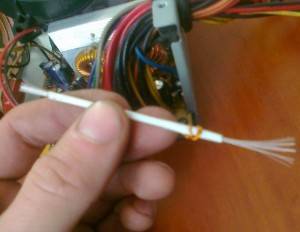
And finally, we lubricate the motor. On the middle of the cooler we see a round sticker, under it there is a fan axis and a bearing or bushing. In some coolers, after you remove the sticker, there is a round plug in the middle; you need to carefully remove it with a needle.
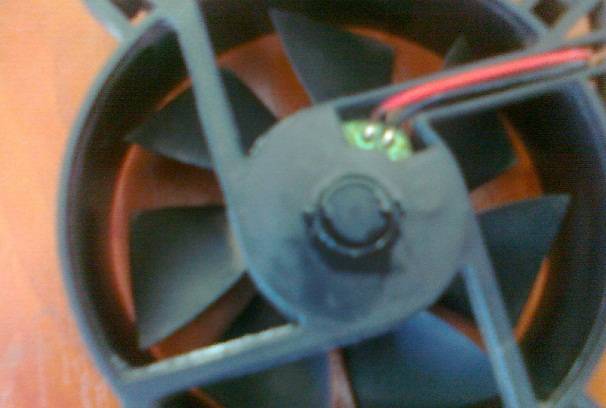
And only then will you see that very axis. Drop a drop of machine oil on this axis, and then glue the sticker back.
That's all. We cleaned the cooler without any difficulties.
We put everything that was dismantled in the reverse order.
Be sure to read:
How do I know the level of wear on a laptop or netbook battery?
How to start an ATX power supply without a computer?
What is the operating temperature of the processor
How to properly assemble a computer from components yourself
Why do you need to clean
Before you start cleaning, you need to understand the reasons for cleaning coolers.
Plaque
The main reason for cleaning the container is to prevent the appearance of plaque, which negatively affects the quality of the water. It appears if you do not rinse or rinse the water cooler for a long time. To avoid plaque, it is necessary to rinse the device once a week.
Scale
Many models of water coolers are equipped with a heating element, which is responsible for heating the liquid. Over time, scale appears in it, which forms due to exposure to hot temperatures. Due to scale, the taste of the water deteriorates.
Bacteria outside
If you do not wash the cooler for a long time, a bacterial biofilm will appear on its contact surfaces and inside. It is very dangerous because it changes the composition of the water and impairs its taste. Regular cleaning will help prevent bacteria build-up.
Algae spores in water
Sometimes a faint greenish coating may appear on the walls of the containers. It indicates the formation of algal spores in the water. This is a seasonal phenomenon, and therefore most often they appear from the beginning of May to the end of September, when solar activity increases.
How to clean a water cooler yourself with citric acid: instructions
Observing all the cleaning steps, you can rinse the device efficiently and efficiently. Today you can find a lot of tips on how to clean a water cooler yourself. All work consists of the following stages:
- Sanitary treatment of the hull.
- Small parts washing.
- Disinfection of internal surfaces.
Before carrying out this procedure, you should thoroughly wash your hands with soap and treat them with an antiseptic solution. Medical gloves can be used for cleaning.
When processing small parts, it is better to use two containers of water. You can put a soapy solution into one basin, and pour boiled water into the other. All parts are washed according to the following scheme:
- The faucets are carefully removed from the device. Remember their location or make appropriate notes on the device. The removed parts are washed in soapy water or left in a container with soapy water for several hours. After that, you can clean all the grooves with a small brush. Clean taps are washed with running water, rinsed in a container with boiled water and dried.
- Start cleaning the drip tray. It looks like a tank with a grid and is located under the taps. It should be disassembled by separating the grate from the pallet. It is washed in the same way as the taps and put back in place after drying.
- The bottle receptacle is pulled out by turning it counterclockwise. They clean it in the same way. Next, go to the divider. It is a plastic circle with two holes located at the bottom of the water tank.
The taps must be screwed in place before washing the receiving tank. It is necessary to fill in special means for cleaning and disinfection, for example, "BIOR1". It can be purchased at any specialty store. For 125 g of the substance, pour 5 liters of liquid. After dissolving the substance, the liquid is poured into the tank through the bottle opening and drained through the taps and an additional valve.
The device must be turned on in the heating mode and the solution must be heated, and then the device must be turned off. Leave the device in this state with the solution for complete disinfection.
After this time, it is necessary to drain the liquid from the tank, taps and valve. If the liquid has a dark color, then the procedure should be repeated until a clear liquid is obtained when draining. Then the tank is filled with clean liquid and drained several times.
The device is dried and put together. They put a new bottle of water in it and connect the device to the power supply. It is not recommended to drink the first two glasses of water from hot and cold taps. They need to be poured out and after that take a new glass and taste the water.If there is a sour taste, rinse the device again.
Why clean your home appliance and how often you should do it
Manufacturers of water purification systems claim that during operation there is no need to often clean them at home. However, in reality, everything turns out to be much more complicated. There are a number of factors that quite often lead to the need to clean the cooler:
- Penetration into the system of pathogenic microorganisms, which, at best, can cause intestinal infection. Despite the seeming tightness of the filter, the simplest forms of life can easily get there.
- Due to the fact that modern devices provide for the possibility of heating water, it is not surprising that from time to time there is a need to descale the cooler.
- Since during operation people do not always touch the external elements of the cleaning system with clean hands, dirt can accidentally get into the cleaned liquid.
- Water of poor quality sometimes contains cells of the simplest algae, which take root inside the apparatus, and begin to actively multiply, covering its inner surfaces with a green bloom.
Many users of household appliances are interested in how often the cooler should be cleaned. When using the device on an ongoing basis, you need to arrange a hygienic procedure at least twice a year. However, in order to avoid problems in further use, experts recommend doing this twice as often. Additionally, it becomes necessary to clean the cooler in the following situations:
- when switching to another brand of water;
- with a deterioration in pressure;
- after a significant break in work;
- with even a barely noticeable deterioration in the taste of water from both cold and hot tap;
- when a yellowish precipitate appears at the bottom of a mug with tea or coffee;
- upon completion of the repair.

Water cooler cleaning: subtleties and nuances
Before proceeding with self-processing, it must be borne in mind that this procedure requires the allocation of free space and takes quite a lot of time. Therefore, it is necessary to prepare in advance a clean bowl for rinsing "little things", a rag made of soft, lint-free cloth, a brush (or a clean toothbrush), a detergent (for a start, "Mister Muscle" will do as well). It is advisable to carry out this procedure in the intervals between replacing the container - this will reduce the likelihood of re-entry of bacteria inside.
 The presence of foreign substances on structural elements leads to their coarsening and a reduction in their service life.
The presence of foreign substances on structural elements leads to their coarsening and a reduction in their service life.
External sanitization
First of all, it is necessary to disconnect the dispenser from the electrical network, then remove the bottle and drain the water. Since disassembling the water cooler with your own hands does not imply any particular difficulties, all external elements are subject to mandatory dismantling: the drip tray grill, decorative panels (if any), as well as the neck opening with a needle for supplying water.
 Bacteria, getting inside the bottle and settling on the walls of tubes and other elements, can cause serious harm to human health.
Bacteria, getting inside the bottle and settling on the walls of tubes and other elements, can cause serious harm to human health.
All external surfaces should be thoroughly wiped with soapy water, to which you can add a little iodine or ammonia.
In the latter case, it is advisable not to forget about the precautions. Thorough washing is required not only for the front - both the back wall and even the power cord need to be well cleaned
 Sanitary treatment of any cooler is a mandatory event that must be carried out periodically with your own hands or with the assistance of professionals.
Sanitary treatment of any cooler is a mandatory event that must be carried out periodically with your own hands or with the assistance of professionals.
Cooler cleaning: cleaning removable parts
All removed parts can be washed in a bowl of cleaning solution (or dishwashing detergent). In this case, before rinsing, it is necessary to thoroughly clean the formed plaque and accumulated dirt. For hard-to-reach places, it is better to use a special brush or toothbrush.
 Remember that plastic parts must not be rubbed with scrapers or metal sponges!
Remember that plastic parts must not be rubbed with scrapers or metal sponges!
As an additional measure, you can spray a disinfectant solution on the removed parts and leave them there for 10-15 minutes. This procedure should be carried out after initial processing. In most cases, flushing a water cooler at home requires a simple rule - it is better to put the cleaned parts separately.
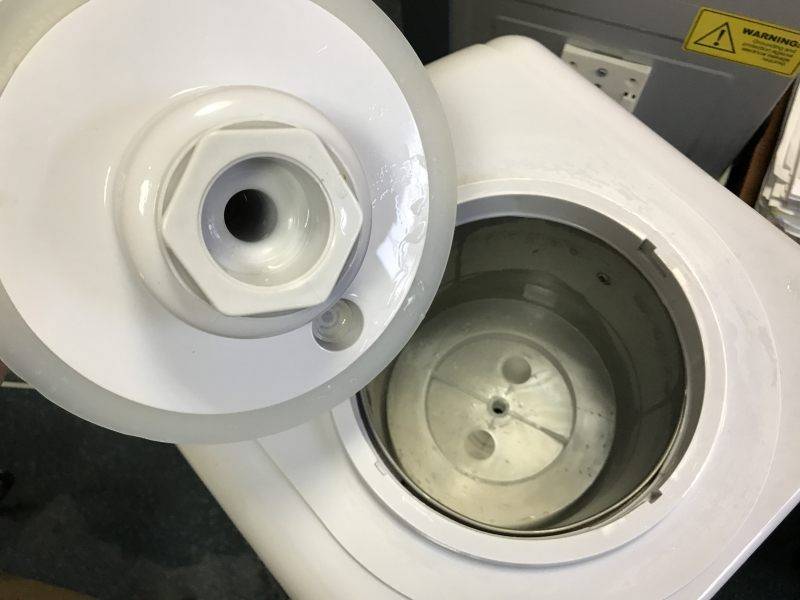 After washing, they must be handled with rubber or disposable gloves.
After washing, they must be handled with rubber or disposable gloves.
Internal processing
Deep cleaning of the dispenser is carried out using a previously prepared solution. For this, both special products produced by the industry can be used, as well as the usual ones: vinegar or citric acid. Usually, a cooler is cleaned in two stages:
-
Disinfection and descaling. The prepared solution is poured into storage tanks until they are completely filled. In this case, both taps are left open to remove air pockets and allow the cleaning fluid to fill all water supply channels and pipelines.
After that, you must turn on the dispenser and wait until the heating indicator goes out. Then, with an interval of 10 minutes, you need to drain a glass of water, alternately from each tap. The drained water is returned back to the cooler. The recommended duration of the entire procedure is about half an hour.
Washing. At this stage, thoroughly rinse all internal parts in contact with the solution. To do this, you need to make a clean spill with four times the volume of a standard 19-liter bottle. Despite the fact that flushing the water cooler at home requires a significant overrun, it is forbidden to use the city water supply as a source!
Additional cleaning
The final stage of cleaning is washing and disinfection of internal removable parts that are in direct contact with water: plastic pipes and lines, taps, separator, as well as all kinds of holders.
When using any detergent, pay attention to the instructions supplied with the device. Not every model can be processed with universal means .. It should be remembered that some models of coolers allow the installation of taps with an internal thread - you need to be careful when dismantling them
Otherwise, cleaning is carried out using the method for washing surfaces described above.
It should be remembered that some models of coolers allow the installation of taps with an internal thread - you need to be careful when dismantling them. Otherwise, cleaning is carried out using the surface cleaning method described above.
 If the appliance is washed regularly, heavy contamination can be avoided.
If the appliance is washed regularly, heavy contamination can be avoided.

